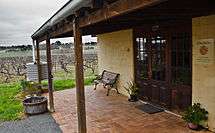Clonakilla
Clonakilla is an Australian winery based in the Canberra wine region of Murrumbateman, New South Wales.
History

Dr. John Kirk immigrated to Australia from the United Kingdom to work as a research scientist at the CSIRO in 1968.[1][2] In 1971, he founded Clonakilla, named after the farm owned by his grandfather in County Clare, Ireland.[3][4][5] The name of the winery translates to "meadow of the church".[6]
Clonakilla was the first commercial winery to open in the region[7] and John Kirk is often referred to as the "father" of the wine industry in the area.[2] The first wines from the estate, a Riesling and a Cabernet Shiraz[8] were produced in 1976 after initial difficulties with droughts and lack of irrigation.[2][9] Like almost all the wineries in the Canberra district, it is not based in the Australian Capital Territory but across the border in New South Wales.[9][10] This is due to the leasehold land system in the ACT which means a business can only lease land from the government and not own it.[11]
After teaching religious education with Jesuits at Xavier College in Melbourne and spending holidays helping at the winery, John's fourth son, Tim Kirk, joined the winery full-time in 1996.[1][3] Tim is currently the chief winemaker and in 2009 was appointed CEO.[12][13]
Wines
The Canberra wine region is a cool climate area and the wines produced by Clonakilla reflect this. Around 10,000 to 12,000 cases of wine are produced each year.[12]
The flagship wine is the Shiraz Viognier co-fermentation, produced from a selection of the best grapes in a single twelve hectare vineyard.[14][15] The two grape types in this wine are co-fermented, with around five to ten percent Viognier and the rest Shiraz, depending on vintage conditions.[1][3] This wine was first produced by Clonakilla in 1992 after Tim Kirk had spent time in the northern Rhone Valley, specifically visiting Guigal, and he decided that it was a style that he wanted to emulate and that it would be well suited to the Canberra region.[1][9][16] The Shiraz Viognier is described by James Halliday as having "icon status"[17] and as being the best example of this wine style in Australia.[18] Jancis Robinson has identified it as the "pioneer" of the blend in Australia.[19] It was recognised at the Outstanding level of the Langton's Classification of Australian Wine in 2005,[20] and was elevated to the highest level of "Exceptional" in 2010.[14]
Other red wines produced include two more Shiraz Viognier blends - an entry-level wine called "Hilltops", and the "O'Riada", named after Irish composer Seán Ó Riada, which sits in between the Hilltops and the flagship Shiraz Viognier[21] as well as a Cabernet Sauvignon, Cabernet Franc and Merlot blend called "Ballinderry".[22] There was also an experimental straight Shiraz released in 2006 and 2008 that spent an extra year in oak.[15]
Clonakilla produces a number of white wines as well - Riesling, a Semillon-Sauvignon blanc blend as well as two straight Viogniers are made, with one Viognier bottling aged in stainless steel and the other aged in oak.[3][21]
The logo displayed on the label of all the Clonakilla wines comes from the Book of Durrow, a seventh-century manuscript.[3]
References
- "The wonderful wines of Clonakilla in Canberra". Green and Blue Wines. 4 May 2010. Archived from the original on 25 January 2013. Retrieved 18 May 2010.
- Cooke, Graham (15 October 2001). "Man who fathered Canberra's wine industry". Canberra Times. Retrieved 18 May 2010.
- "From Clare to there - The Irish Times Via Thomson Dialog NewsEdge". It.tmcnet.com. 18 February 2006. Retrieved 18 May 2010.
- Clack, Peter (8 October 2002). "Canberra District Shiraz Takes out Wine of the Year Award". Canberra Times. Retrieved 18 May 2010.
- "Stateline - Wine Harvest". Abc.net.au. 30 March 2007. Retrieved 18 May 2010.
- Meacham, Steve (16 June 2007). "Hunter Now the Hunted". Melbourne: The Age. Retrieved 18 May 2010.
- "Canberra at the heart of wine industry". NZHerald. 26 June 2001. Retrieved 18 May 2010.
- Clarke, Oz (2005). Oz Clarke's Australian Wine Companion. Mariner Books. p. 97. ISBN 978-0-15-603025-0.
- "Canberra - Australian Politics and wines of unusual subtlety". Jancis Robinson. Retrieved 18 May 2010.
- "Sydney Morning Herald - Journey around NSW, a state of grapes". Smh.com.au. 7 March 2005. Retrieved 18 May 2010.
- "Meeting Place". Wine Pages. 25 September 2000. Archived from the original on 11 August 2010. Retrieved 18 May 2010.
- Clonakilla.com.au - Our Story Archived 3 October 2010 at the Wayback Machine
- "Wine Companion - Up with the best". Archived from the original on 4 December 2010. Retrieved 20 September 2010.
- "Clonakilla Shiraz Viognier Canberra District ACT". Langtons.com.au. Archived from the original on 30 September 2009. Retrieved 18 May 2010.
- "Langton's Magazine - THE CLONAKILLA DILEMMA". Langtons.com.au. Archived from the original on 2 July 2010. Retrieved 18 May 2010.
- "National Liquor News - Southern Highlights". Foodwinetravel.com.au. Archived from the original on 13 October 2009. Retrieved 18 May 2010.
- Halliday, James (2004). Varietal Wines. Collins. p. 223. ISBN 0-7322-7839-2.
- "Clonakilla rating and review". Wine Companion. Retrieved 18 May 2010.
- "New South Wales Tasting Notes & Wine Reviews". Jancis Robinson. Retrieved 18 May 2010.
- "Out with the old". Melbourne: The Age. 2 August 2005. Retrieved 18 May 2010.
- "The Age - Shiraz with Dash". Melbourne: Newsstore.theage.com.au. 15 August 2009. Retrieved 18 May 2010.
- "The wines of Clonakilla". Wine Anorak. Retrieved 18 May 2010.